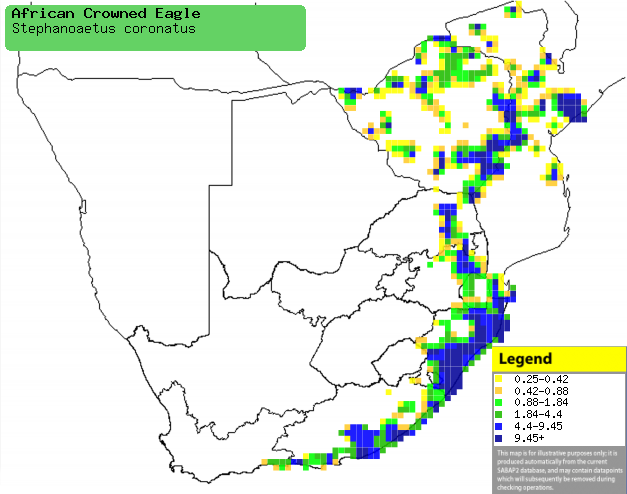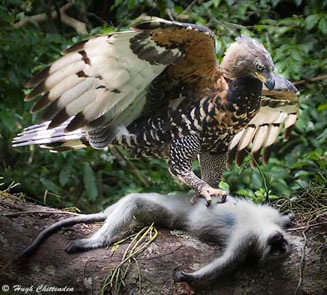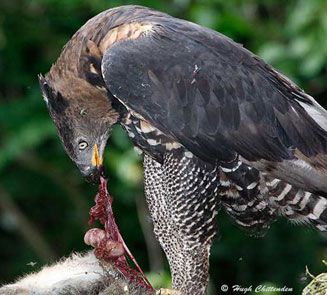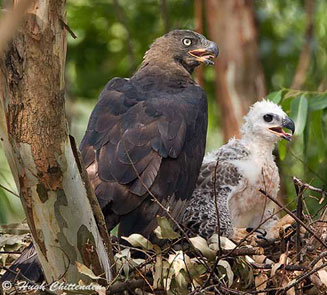|
Stephanoaetus coronatus
(African crowned eagle, Crowned eagle)
Kroonarend [Afrikaans]; Ukhozi (generic term for eagle)
[Xhosa]; isiHuhwa (also applied to Martial eagle) [Zulu]; Kroonarend
[Dutch]; Aigle couronné [French]; Kronenadler [German]; Águia-coroada
[Portuguese]
Life
> Eukaryotes >
Opisthokonta
> Metazoa (animals) >
Bilateria >
Deuterostomia > Chordata >
Craniata > Vertebrata (vertebrates) > Gnathostomata (jawed
vertebrates) > Teleostomi (teleost fish) > Osteichthyes (bony fish) > Class:
Sarcopterygii (lobe-finned
fish) > Stegocephalia (terrestrial
vertebrates) > Tetrapoda
(four-legged vertebrates) > Reptiliomorpha > Amniota >
Reptilia (reptiles) >
Romeriida > Diapsida > Archosauromorpha > Archosauria >
Dinosauria
(dinosaurs) > Saurischia > Theropoda (bipedal predatory dinosaurs) >
Coelurosauria > Maniraptora > Aves
(birds) >
Order: Falconiformes > Family: Accipitridae
Distribution and habitat
Occurs from Guinea to South Africa, with an isolated population in
Ethiopia. In southern Africa, it is generally uncommon in Zimbabwe,
central Mozambique and eastern and southern South Africa. It generally prefers
forest habitats, such as gallery forest, dense woodland, forest gorges in savanna
or grassland and alien tree plantations (such as Eucalyptus and pine).
|
 |
|
Distribution of African crowned eagle in southern Africa,
based on statistical smoothing of the records from first SA Bird Atlas
Project (©
Animal Demography unit, University of
Cape Town; smoothing by Birgit Erni and Francesca Little). Colours range
from dark blue (most common) through to yellow (least common).
See here for the latest distribution
from the SABAP2. |
Food
 |
 |
|
African crowned eagle feeding on a Vervet Monkey (Chlorocebus
pygerythrus) which it had just caught, Dlinza forest, KwaZulu-Natal,
South Africa. [photo
Hugh Chittenden ©] |
It mainly eats mammals (especially hyraxes and antelope),
doing most of its hunting from a perch just below the canopy, swooping down on
its prey from above. Pairs sometimes hunt cooperatively to catch monkeys (such
as in the photos above), using a clever technique whereby one bird flies above
the canopy overhead of a monkey troop, eliciting alarm calls from them which
exposes their position. The eagle's mate then follows a short while later,
killing from behind any monkey unfortunate enough to be caught out in the open.
It usually strikes the skull or diaphragm of prey with its talons in a downward
motion, a movement powerful enough to kill instantly. The following food items have been recorded
in its diet:
- Mammals
- Birds
- Reptiles
- Fish (rarely)
Breeding
- The nest (see image below) is built mainly by the female in about 5-6
weeks, consisting of a large platform built of branches up to about 1.5
metres long and lined with the leaves of Willow beachwood (Faurea saligna)
and Eucalytus. It is typically placed in the highest forked branch of
the tallest available smooth-barked tree, about 15-55 metres above ground.
It is often positioned at the base of a ravine or at the edge of a
plantation, using the same site over multiple breeding seasons and only
rebuilding a new nest if the previous one is lost.
 |
|
|
African crowned eagle at its nest with chick,
Dlinza forest, KwaZulu-Natal, South Africa. [photo
Hugh Chittenden ©] |
|
- Egg-laying season is from July-May, peaking from August-October.
- It lays 1-2, usually 2 eggs, which are incubated mainly the female for
about 49-51 days. Occasionally when the male is incubating the female gives
him prey as a gift, a unique behaviour among African eagles.
- The chicks are brooded by the female for the first 21 days or so of
their lives, while the male hands her a prey item to feed to them every
circa one and a half days, never feeding them himself. When the young become
about 60 days old the female starts to hunt for them as well, soon
surpassing the male in deliveries of food to the nest. Even though it
usually lays 2 eggs, only one chick usually lives to become a juvenile,
meaning that it is highly likely that one chick kills and eats the other at
some point during the nestling period. At about 110-115 days old the lone
nestling typically clambers on to the branches surrounding the nest and
takes its first flight, remaining reliant on its parents for food for 9-11
months longer before becoming fully independent.
Threats
Not threatened internationally but Near-threatened
in South Africa, largely due to persecution by small stock farmers and
destruction of forest habitats, although it has adapted to living in alien tree
plantations which somewhat counteracts the latter.
References
-
Hockey PAR, Dean WRJ and Ryan PG 2005. Roberts
- Birds of southern Africa, VIIth ed. The Trustees of the John Voelcker
Bird Book Fund, Cape Town.
-
Harrison, J.A., Allan, D.G., Underhill, L.G., Herremans, M.,
Tree. A.J., Parker, V. & Brown, C.J. (eds). 1997. The atlas of southern
African birds. Vol. 2: Passerines. BirdLife South Africa, Johannesburg.
|
